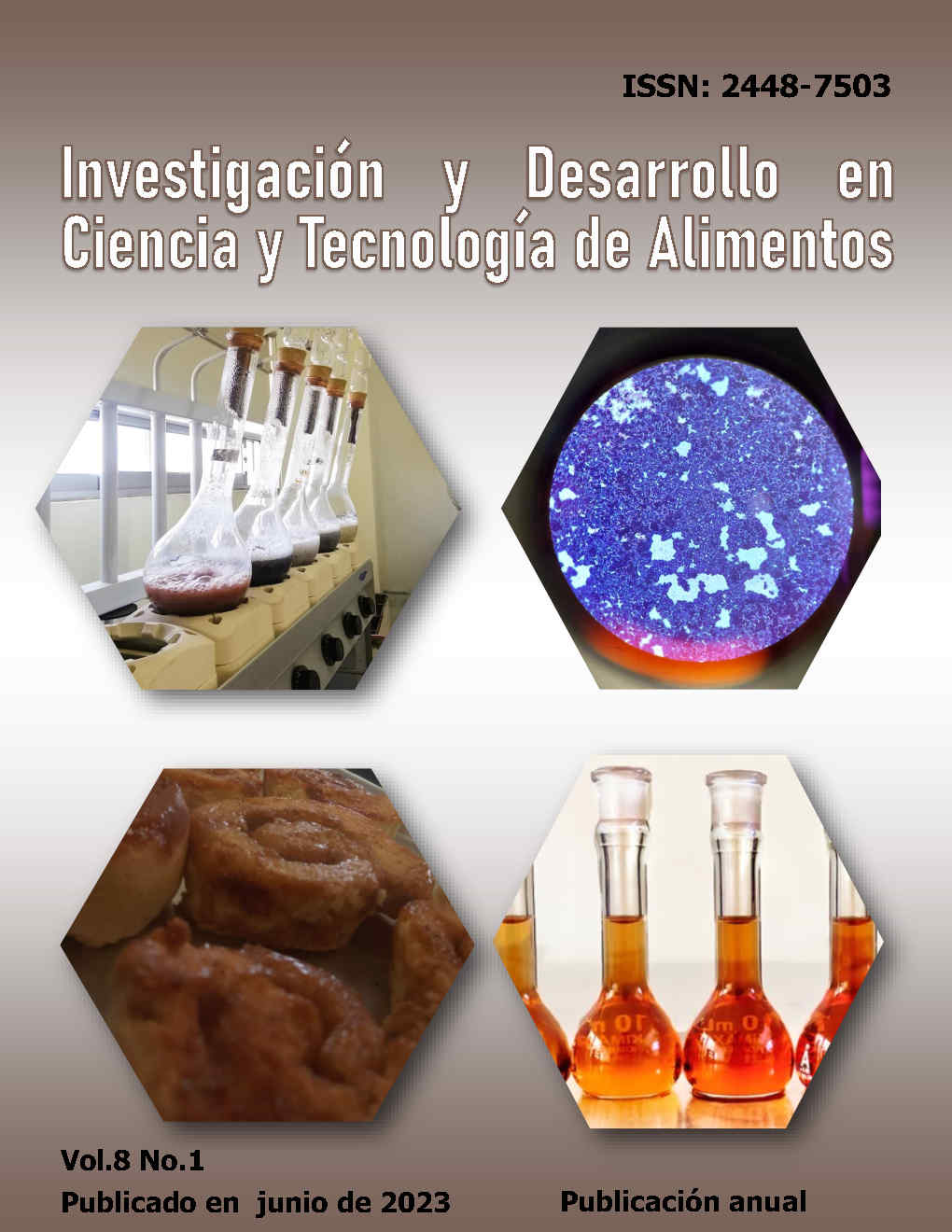El fruto de Opuntia oligacantha var. Ulapa, fuente potencial de fitoquímicos
DOI:
https://doi.org/10.29105/idcyta.v8i1.29Keywords:
Phytochemicals, antioxidants, betalains, nutrients, human healthAbstract
The fruits of Opuntia spp. (xoconostle) are widely consumed in several regions of Mexico, which denotes its gastronomic acceptability and accessibility, for taste and low acquisition costs. However, its nutritional quality and bioactive compounds can change according to the state of maturity, agroclimatic conditions, and genetic variability. Therefore, the aim of this research was to present the most recent information of the Ulapa xoconostle, cultivated at the region of Ulapa of Melchor Ocampo, Hidalgo, Mexico. The evaluation of the physicochemical properties such as color, total soluble solids (TSS), pH, and titratable acidity (TA) were carried out. The content of total phenols and flavonoids was evaluated; additionally, total betalains were determined. The results showed a high content of betalains and flavonoids compared to other species previously studied in Mexico. The concentrations of these phytochemicals present in the xoconostle make it a permanent and alternative source of bioactive compounds.
Downloads
References
Association of Official Analytical Chemists (AOAC). (2005). Official Methods of Analysis. Horwitz, W. (ed). 18th Ed. AOAC International, Gaithersburg, MD, USA.
Belhadj, S. I., Najar, T., & Abderrabba, M. (2017). Chemical and Antioxidant Properties of Betalains. Journal of Agricultural and Food Chemistry, 65(21), 675–689. DOI: https://doi.org/10.1021/acs.jafc.6b04208
Cai, Y., Sun, M., & Corke, H. (1998). Colorant properties and stability of Amaranthus betacyanin pigments. Journal of Agricultural and Food Chemistry, 46, 4491–4495. DOI: https://doi.org/10.1021/jf980457g
Chavez-Santoscoy, R. A., Gutiérrez-Uribe, J. A., & Serna-Saldívar, S. O. (2009). Phenolic composition, antioxidant capacity and in vitro cancer cell cytotoxicity of nine prickly pears (Opuntia spp.) juices. Plant Food for Human Nutrition, 64(2), 146–152. DOI: https://doi.org/10.1007/s11130-009-0117-0
Díaz-Vela, J., Totosaus, A., Cruz-Guerrero, A. E., & Pérez-Chabela, M. L. (2013). In vitro evaluation of the fermentation of added-value agroindustrial by-products: cactus pear (Opuntia ficus-indica L.) peel and pineapple (Ananas comosus) peel as functional ingredients. International Journal of Food Science and Technology, 48(7), 1460–1467. DOI: https://doi.org/10.1111/ijfs.12113
Gandía-Herrero, F., Escribano, J., & García-Carmona, F. (2016). Biological activities of plant pigments betalains. Critical Reviews in Food Science and Nutrition, 56(6), 937–945. DOI: https://doi.org/10.1080/10408398.2012.740103
Gallegos-Vázquez, C., Scheinvar, L., Núñez-Colín, C., & Mondragón-Jacobo, C. (2012). Morphological diversity of xoconostles (Opuntia spp.) or acidic cactus pears: A Mexican contribution to functional foods. Fruits, 67(2), 109–120. DOI: https://doi.org/10.1051/fruits/2012001
Guzmán-Maldonado, S. H., Morales-Montelongo, A. L., Mondragón-Jacobo, C., Herrera-Hernández, G., Guevara-Lara, F., & Reynoso-Camacho, R. (2010). Physicochemical, nutritional, and functional characterization of fruits xoconostle (Opuntia matudae) pears from Central-México region. Journal of Food Science, 75(6), 485–492. DOI: https://doi.org/10.1111/j.1750-3841.2010.01679.x
Hernández-Fuentes, A. D., Trapala-Islas, A., Gallegos-Vásquez, C., Campos-Montiel, R. G., Pinedo-Espinoza, J. M., & Guzmán-Maldonado, S. H. (2015). Physicochemical variability and nutritional and functional characteristics of xoconostles (Opuntia spp.) accessions from Mexico. Fruits, 70(2), 109–116. DOI: https://doi.org/10.1051/fruits/2015002
Lemos, F. A., Pereira de Andrade, A., Alcantara, R. L., Cordeiro dos Santos, D., Rodrigues, A. L., & Soares da Silva, D. (2017). Chemical and Nutritional Variability of Cactus Pear Cladodes, Genera Opuntia and Nopalea. American Journal of Food Technology, 12(1), 25–34. DOI: https://doi.org/10.3923/ajft.2017.25.34
López-Martínez, C. R., García-Mateos, R., Gallegos-Vázquez, C., & Sahagún-Castellanos, J. (2015). Antioxidant components and nutritional quality of 15 genotypes of Xoconostle (Opuntia spp.) Journal of the Professional Association for Cactus Development, 17, 33–49. DOI: https://doi.org/10.56890/jpacd.v17i.60
Morales, P., Ramírez-Moreno, E., Sánchez-Mata, M., Carvalho, A., & Ferreira, I.C.F.R. (2012). Nutritional and antioxidant properties of pulp and seeds of two xoconostle cultivars (Opuntia joconostle F.A.C. Weber ex Diguet and Opuntia matudae Scheinvar) of high consumption in Mexico. Food Research International, 46(1), 279–285. DOI: https://doi.org/10.1016/j.foodres.2011.12.031
Morales, P., Barros, L., Ramírez-Moreno, E., Santos-Buelga, C., & Ferreira, I. (2014). Exploring xoconostle by-products as sources of bioactive compounds. Food Research International, 65(1), 437–444. DOI: https://doi.org/10.1016/j.foodres.2014.05.067
Nilsson, T. (1970). Studies into the pigments in beetroot. Langbrukshogskolans Annaler, 36, 179–83.
Osorio-Esquivel, O., Ortiz-Moreno, A., Álvarez, V., Dorantes-Álvarez, L., & Giusti, M. (2011). Phenolics, betacyanins and antioxidant activity in Opuntia joconostle fruits. Food Research International, 44(7), 2160–2168. DOI: https://doi.org/10.1016/j.foodres.2011.02.011
Rosales, M. A., Cervilla, L. M., Sánchez-Rodríguez, E., Rubio-Wilhelmi, M. D. M., Blasco, B., Ríos, J. J., & Ruiz, J. M. (2011). The effect of environmental conditions on nutritional quality of cherry tomato fruits: evaluation of two experimental Mediterranean greenhouses. Journal of the Science of Food and Agriculture, 91(1), 152–162. DOI: https://doi.org/10.1002/jsfa.4166
Singleton, V. L., & Rossi, J. A. (1965). Colorimetry of total phenolics with phosphomolybdic phosphotungstic acid reagents. American Journal of Enology and Viticulture, 16(3), 144–158. DOI: https://doi.org/10.5344/ajev.1965.16.3.144
Downloads
Published
How to Cite
Issue
Section
License
Copyright (c) 2023 C.U. López-Palestina, Y.O. Santiago-Saenz, J. Gutiérrez-Tlahque, A.D. Hernández-Fuentes, J.M. Alatorre-Cruz, J.M. Pinedo-Espinoza

This work is licensed under a Creative Commons Attribution 4.0 International License.
Los autores/as que publiquen en esta revista aceptan las siguientes condiciones:
a. Los autores/as conservarán sus derechos de autor y garantizarán a la revista el derecho de primera publicación de su obra, el cual estará simultáneamente sujeto a la Licencia Creative Commons Atribución 4.0 Internacional. que permite a terceros compartir la obra siempre que se indique su autor y su primera publicación esta revista.
b. Los autores/as pueden realizar otros acuerdos contractuales independientes y adicionales para la distribución no exclusiva de la versión del artículo publicado en esta revista (p. ej., incluirlo en un repositorio institucional o publicarlo en un libro) siempre que indiquen claramente que el trabajo se publicó por primera vez en esta revista.
c. Se permite y recomienda a los autores/as a publicar su trabajo en Internet (por ejemplo en páginas institucionales o personales) posterior al proceso de revisión y publicación, ya que puede conducir a intercambios productivos y a una mayor y más rápida difusión del trabajo publicado.





